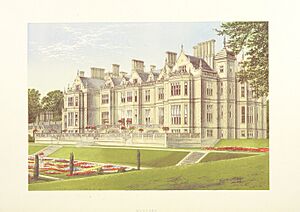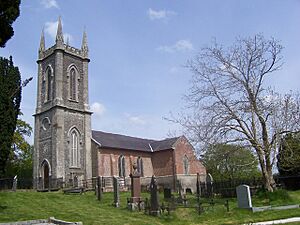Dartrey Forest facts for kids
Dartrey Forest, located near Rockcorry in north-west County Monaghan, Ireland, was once part of a huge estate called Dartrey. It was also known as "Dawson Grove." This was the country home of the Dawson family. They held the title Earl of Dartrey from 1866 to 1933. The heart of this large estate was Dartrey Castle, which was taken down in 1946.
Today, Coillte manages Dartrey Forest. It is used as a commercial forest. Part of the forest is next to a wall known as 'the Famine Wall'. This wall stretches along the road from Cootehill to Rockcorry (the R188). Near the forest's main gate, across the R188 road, stands the Dawson Monument. This is a beautiful neo-Classical column. It was designed by James Wyatt and built around 1808.
The area around the forest is very beautiful. It has many lakes connected by the Dromore River. An old description from 1844 said the river banks offered "very rich close landscapes." These landscapes were described as "languishingly beautiful." The lakes also have several crannógs. These were old island forts used for protection, possibly until the late 1500s. They might have also helped with trade along the river.
Black Island and The Mausoleum
Between the lakes is Black Island. This is a large and very pretty island. On it, you'll find a building known as The 'Temple' or The Mausoleum. Its official name is the Dawson Mausoleum. This building is very important for architecture in Ireland. Sadly, it has fallen into disrepair over many years.
James Wyatt designed the mausoleum in 1770. It looks like the Pantheon in Rome. According to John R. Redmill, a top Irish architectural conservationist, it is "one of the most important 18th century buildings in Ireland." Even though it has been without a roof for 40 years, local groups are working to save and restore it. The Dartrey Heritage Association is leading these efforts. The building was meant to be a mausoleum, but no one was ever buried there. Still, it stands as a symbol of sadness and loss.
Black Island is connected to the mainland by the Iron Bridge. This is a lovely iron structure. It also needs to be restored.
Dartrey Castle and Church
Dartrey Forest mostly covers what was once the 'demesne' or park. This park surrounded Dartrey Castle. The castle was also called Dartrey House or Dawson Grove. It was a large neo-Elizabethan country house. Most of it was built in the 1840s, during the time of the Great Famine in Ireland. The castle was the main building of the huge Dartrey Estate.
The famous British architect William Burn designed the mansion. It was built for The 3rd Baron Cremorne. He later became The 1st Earl of Dartrey. This early Victorian house was built where an older house, Dawson Grove, once stood. The old house was from the 1770s. Lord Cremorne, who became an important politician, had the old Dawson Grove changed and made much bigger. This created a whole new house.
The new 'castle' was on the western shore of the Inner Lough. This lake is separated from Dromore Lough by Black Island. A fire damaged part of the newly rebuilt house in March 1856. After this, the house was rebuilt again in the neo-Elizabethan style. Most of the castle's belongings were sold in 1937. Dartrey Castle, a well-known Irish country house, was taken down in 1946. Only the castle's old stables and part of the farmyard remain today.
Close to where the castle stood is the Church of St. John the Evangelist. People often just call it Dartrey Church. This neo-Gothic church belongs to the Church of Ireland. It was built on the edge of the townland of Kilcrow. The church was first built in the late 1720s and early 1730s. It was partly rebuilt throughout the 1800s. It is still used today.
Dartrey Kingdom
The area where Dartrey Forest is now was once part of a larger region. This region was called Dartrey (or Dartraighe). It stretched north to Clones. The McMahons and O'Boylans ruled this land. The name comes from the Dartraige, who were known as the 'calf people'. They were an old Irish tribe. They lived in parts of north Roscommon, east Sligo, west Leitrim, and southern Monaghan.
Dartrey was a smaller kingdom within the larger Kingdom of Airgíalla. At one time, Airgíalla stretched from Lough Neagh to Lough Erne. But it mainly covered what is now County Monaghan and County Louth. The king and queen of Airgíalla were very important. They sat next to the High King at Tara during big meetings. The High King even allowed the Airgíalla king's sword to touch his hand. This showed great trust.
The Airgíalla kingdom's land became smaller over time. This happened as Armagh became a more important religious center. Also, the Airgíalla allied with the Northern and Southern Ui Neill. These groups controlled politics and served as High King of Ireland from the Hill of Tara. The kingdom got even smaller after the Normans conquered parts of Ireland in the 12th century.
The Book of Rights lists the tribes of Airgíalla from the 5th century. It also tells what they were allowed to receive from the king of Airgíalla. The bard Benén wrote a poem to remember these rights and benefits.
Benén's Poem
1. This problem rests upon the descendants of the Collas, the bright host of Liathdruim, that they do not know the amount of their payment, from the king of bright Fuaid.
2. Here is the tradition—I shall tell it for you— of the descendants of gentle Cairpre: learn, people of Fál of the fiana, the handsome payments of the Airgialla...
16. The king of Dartraige, a flame of bravery, is allowed four servants for hard work, four swords strong in battle, four horses, and four golden shields...
20. Here is the tradition of the armies, whom Benén always loved: it is a great puzzle to all the learned, except for one who knows the evidence well.
as Gaeilge (original)
1. In cheist sea for chloind Cholla for sluag luchair Liathdroma can fis a tuarastail tall ó ríg Fuaid na find-fearand.
2. Atá sund, sloindfed-sa daíb senchos cloindi Cairpri chaím: cluinid, a lucht Fáil na fian, tuaristla áilli Airgiall.
16. Dligid rí Dartraigi, in daig, ceithri mogaid mórastair, ceithri claidim chruaidi i cléith, ceithri heich, ceithri hór-scéith.
20. Atá sund senchas na slóg dá tuc grád co bráth Beneón; acht int í bus treórach teist ar cach n-eólach is ard-cheist.




